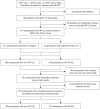Development of a machine learning model in prediction of the rapid progression of interstitial lung disease in patients with idiopathic inflammatory myopathy
- PMID: 39698644
- PMCID: PMC11652001
- DOI: 10.21037/qims-24-595
Development of a machine learning model in prediction of the rapid progression of interstitial lung disease in patients with idiopathic inflammatory myopathy
Abstract
Background: Rapidly progressive interstitial lung disease (RP-ILD) significantly impacts the prognosis of patients with idiopathic inflammatory myopathies (IIM). High-resolution computed tomography (HRCT) is a crucial noninvasive technique for evaluating interstitial lung disease (ILD). Utilizing quantitative computed tomography (QCT) enables accurate quantification of disease severity and evaluation of prognosis, thereby serving as a crucial computer-aided diagnostic method. This study aimed to establish and validate a machine learning (ML) model to predict RP-ILD in patients with idiopathic inflammatory myopathy-related interstitial lung disease (IIM-ILD) based on QCT and clinical features.
Methods: A total of 514 patients (367 females, median age 54 years) with IIM-ILD in the China-Japan Friendship Hospital were retrospectively included, out of which 249 cases (165 females, median age 55 years) were identified as having RP-ILD. To extract the quantitative features on HRCT, deep learning (DL) methods were employed, along with demographic factors, pulmonary function test results, and blood gas analysis results; these factors were integrated into a final prediction model.
Results: Logistic regression was chosen as the final model due to its superior area under the curve (AUC) and explainability compared to the other seven ML models. The validation dataset yielded an AUC of 0.882 [95% confidence interval (CI): 0.797-0.967], indicating that the combined QCT and clinical features model outperformed both the QCT-only model and the clinically-only model. In calibration and clinical decision curve analysis, the final model demonstrated minimal prediction bias (concordance index: 0.887, 95% CI: 0.800-0.974, P<0.001) and provided greater net benefit across most thresholds. The nomogram encompassed the incorporation of the following variables: subtype, gender, forced expiratory volume in one second (FEV1%), diffusing capacity for carbon monoxide (DLCO%), oxygenation index (OI), and quantitative ground-glass opacities (GGOs), consolidation, pulmonary vascular, and branches on HRCT.
Conclusions: When utilizing ML techniques, the baseline QCT has the potential to predict rapid progression in patients with IIM-ILD. The prediction performance will be further improved by incorporating clinical data alongside HRCT features.
Keywords: Idiopathic inflammatory myopathy (IIM); rapidly progressive interstitial lung disease (RP-ILD); high-resolution computed tomography (HRCT); machine learning (ML); quantitative computed tomography (QCT).
2024 AME Publishing Company. All rights reserved.
Conflict of interest statement
Conflicts of Interest: All authors have completed the ICMJE uniform disclosure form (available at https://qims.amegroups.com/article/view/10.21037/qims-24-595/coif). The authors have no conflicts of interest to declare.
Figures




Similar articles
-
18F-FDG PET/CT and HRCT: a combined tool for risk stratification in idiopathic inflammatory myopathy-associated interstitial lung disease.Clin Rheumatol. 2022 Oct;41(10):3095-3105. doi: 10.1007/s10067-022-06239-3. Epub 2022 Jun 27. Clin Rheumatol. 2022. PMID: 35759126
-
Multiple values of 18F-FDG PET/CT in idiopathic inflammatory myopathy.Clin Rheumatol. 2017 Oct;36(10):2297-2305. doi: 10.1007/s10067-017-3794-3. Epub 2017 Aug 22. Clin Rheumatol. 2017. PMID: 28831580
-
The lungs were on fire: a pilot study of 18F-FDG PET/CT in idiopathic-inflammatory-myopathy-related interstitial lung disease.Arthritis Res Ther. 2021 Jul 23;23(1):198. doi: 10.1186/s13075-021-02578-9. Arthritis Res Ther. 2021. PMID: 34301306 Free PMC article.
-
A Systematic Review and Metaanalysis of Predictors of Mortality in Idiopathic Inflammatory Myopathy-Associated Interstitial Lung Disease.J Rheumatol. 2023 Mar;50(3):373-383. doi: 10.3899/jrheum.220383. Epub 2022 Sep 1. J Rheumatol. 2023. PMID: 36379584
-
Determinants for worsening in systemic autoimmune rheumatic disease-associated interstitial lung disease: a systematic review and meta-analysis of cohort studies.Front Med (Lausanne). 2024 Nov 27;11:1465753. doi: 10.3389/fmed.2024.1465753. eCollection 2024. Front Med (Lausanne). 2024. PMID: 39664314 Free PMC article.
Cited by
-
Integration of clinical and serological biomarkers in a nomogram for predicting interstitial lung disease in idiopathic inflammatory myopathies.BMC Rheumatol. 2025 Jul 1;9(1):73. doi: 10.1186/s41927-025-00534-7. BMC Rheumatol. 2025. PMID: 40598457 Free PMC article.
-
ERS Congress 2024: highlights from the Interstitial Lung Diseases Assembly.ERJ Open Res. 2025 Mar 10;11(2):01146-2024. doi: 10.1183/23120541.01146-2024. eCollection 2025 Mar. ERJ Open Res. 2025. PMID: 40071274 Free PMC article.
References
-
- Xu L, You H, Wang L, Lv C, Yuan F, Li J, et al. Identification of Three Different Phenotypes in Anti-Melanoma Differentiation-Associated Gene 5 Antibody-Positive Dermatomyositis Patients: Implications for Prediction of Rapidly Progressive Interstitial Lung Disease. Arthritis Rheumatol 2023;75:609-19. 10.1002/art.42308 - DOI - PubMed
LinkOut - more resources
Full Text Sources
